IDS-25 FAQs
By Roger Russell
These pages are copyrighted
No portion of this site may be reproduced in whole or in part
without written permission of the author.
Background
In 1978, I first used a loudspeaker
column in my design of the McIntosh XRT-20 and later the XRT-22. Among several
benefits are lower distortion, greater power handling and improved vertical
response. However, the tweeter column is only part of the system and only
covers the range from 1500 to 20,000Hz. An 8” mid-range and 2 12” woofers
provide the rest. The column runs essentially from floor to ceiling. Compared
to a single tweeter, sound from the tweeter column appears to originate at your
listening height, standing or sitting. This impression is how we hear and is
known as the precedence or Haas effect. Transients also appear better defined.
I was awarded two patents for the system.
The McIntosh XR290 is a more
recent design. I combine three separate, long columns, one for lows, one for
mids, and one for highs . This increases the advantages for the column design
in several respects. The sound from all frequencies now appears to come from
your listening height. Although improved, some transient information still lost
because it comes from three different locations with three different arrival
times. In addition, crossover networks are still required that divide up the
frequencies and transient information to the appropriate columns. More clues
are still needed for us to hear the original signal clearly. In a way, a
coaxial speaker with a tweeter mounted in the center can come closer to a point
source and transients can be improved compared to ordinary systems.
Nevertheless, coaxial speakers are usually accomplished using crossover
networks, however simple they may be.
A wide-range driver might be
the answer. It must be small and light and radiate highs over a wide angle.
This conflicts with the requirement to have a large area to radiate low
frequencies. A single long column of many small, wide-range drivers has a very
large radiating area as well as wide dispersion. With a little help from
electronic equalization prior to the power amplifier, low frequency response
can be extended easily to 20Hz. The sound radiated from each driver in the long
column has the same frequency and transient information. The sound also appears
to come from the area closest to your listening height at all frequencies. No
crossover networks are needed. By combining all the desired features and a
second patent, I have created a single long column that radiates the whole
frequency range. You could say that this design is made specifically to
complement how we hear. Short columns, curved columns or multiple adjacent
columns covering the same or different frequencies do not meet this objective.
The IDS-25 is an answer that
is ahead of its time and may be a harbinger of things to come. The single full
range column works even better than I had anticipated. The IDS-25 system
outperforms all of my earlier designs, column or conventional multi-way. Here
is truly a unique system that can deliver more accurate sound reproduction and
at levels equal to that which you would encounter at a concert hall. It brings
out the dynamic sound in music that is otherwise lost. The coherency preserves
the alignment of the transients to accurately deliver musical peaks whether it
is from cymbals, piano or drums.
Instead of keeping my design
of the IDS-25 a secret, I decided to share my findings as a 10-page
construction article for the do-it-yourself enthusiasts. The article is titled
“Upgrading A Unique Stereo Column System.” and was published in the July 2006
issue of audioXpress magazine.
Earlier, I had written an
article titled “A Unique Stereo Column System” that was published in the
November 2005 issue of audioXpress magazine. I used
inexpensive small, wide-range drivers. In fact, the cost to build a pair of
systems was under $200. Ignoring cost, however, it clearly demonstrated the
advantages of a single wide-range column. Curiosity kept my interest to create
a new column system with small high-quality drivers. and that led to the IDS-25
design. I hope that some enthusiasts will also be able to experience the clear,
dynamic sound that a single, wide-range column can reveal.
Here are the answers to some of your
questions.
1. What do the letters IDS stand for?
They describe some of the outstanding features of the system: imaging, depth and spaciousness. The goal is to create a system that accurately reveals these listening qualities and at the same time offer many other advantages. Imaging is the ability of a speaker to reproduce stereo information so that the listener is able to locate instruments as they were positioned in the actual performance or as they were mixed at the discretion of the engineer at the console. Depth is the illusion that the instruments are located at various distances behind the plane formed by the two speakers. Spaciousness is the illusion of reverberation, either natural or artificial, giving the impression of a very large room or enclosure having reflections with various amplitudes, time delays or frequency shifts. The synthesized spaciousness used today in popular and electronic music is extremely appealing.
2. Why does the IDS-25 have better imaging, depth and spaciousness than other systems.
Because ALL of the frequencies are radiated from all of the drivers that are all in the same vertical line. There is no image distortion. This offers greater accuracy over multiple columns, each radiating the same or different frequency ranges.
An example of image distortion is when the fundamental tone of a violin is in one place but the harmonics of that note are in other places, the location and sound of the complete instrument is indistinct. However, if all of the sound from the violin appears to comes from the same place, the sound is more realistic. Then, when all the instruments in the orchestra are playing, it enables you to experience their complete sound at their individual locations without getting all muddied up with each other. This is true whether you are listening to the softest or loudest passages. The superior imaging of the IDS-25 lets you locate the entire characteristic sound of each instrument more accurately in space and details are incredibly realistic. The images remain stable, regardless of frequency or of listening height.
4. Is the IDS-25 a dipole radiator?
No. Some designs depend on drivers that face in different directions or have radiation from the rear as well as the front. This approach uses the room environment to provide multiple reflections that might be like what happens in a concert hall. However, in the real world, the reflections and absorption of the listening environment control this “room sound” and each listening room is different. This is hardly the way to convey what is in the recording by adding extra room sound to the concert hall sound already in the recording. In addition, a dipole speaker must be placed out in the room. The IDS-25 was designed to be used within a few inches of the wall or even mounted in the wall. The IDS 25 preserves the recording and minimizes the room sound. It does this using only a single column that radiates only around the front and distributes all frequencies throughout the height of the room.
5. Does the system have a “sweet spot” where you must sit for good sound?
No. Typical multi-way systems radiate sound that changes when you are standing and then sit down. When you try this with the IDS-25, the sound, whether it is stereo or monophonic, does not change at any listening height. In the vertical dimension, the sound will always appear to come from an area centered at the region of your listening height. In the horizontal dimension, stereo sound can seem to come from almost anywhere but the speakers. Sounds can be located in a wide horizontal area. Even if you are listening way over to one side in front of one of the speakers, you can still hear excellent stereo, depth and spaciousness.
However, when listening to monophonic program
material things are different. The sound will depend on your listening
location. If you are at the center between the speakers, the sound will appear
to come from the center. As you move to the side, the sound will tend to follow
you and if you are in front of just one speaker, the sound will appear to come
only from that speaker and not the other one. This effect will remain the same
at any listening height. No matter how the recordings are made, the sound
images will be revealed with improved accuracy when heard with a pair of the
IDS-25 Stereo Loudspeaker Systems.
RETURN
6. How does the IDS-25 column avoid room reflections?
The IDS-25 column extends
from floor to ceiling. The response is very uniform in front of the column but
does not radiate most of the frequency range beyond the ends. Since the ends
are at the floor and ceiling it means that reflections that would normally
interfere with the direct radiation are effectively eliminated. This is a
significant advantage over normal systems that not only radiate sound as much
vertically as horizontally but also exhibit response changes with listening
height. In addition, low frequency room resonances can be greatly reduced
because the lows are being distributed all along the height of each column,
exciting room resonances at lower amplitude. In comparison, subwoofers located
on the floor can build up some room resonances at very high amplitude.
RETURN
7. Why must the column be so tall? Will a short column work just as well?
With fewer drivers, the power handling is reduced and the acoustic gain of the column is reduced, making it less efficient and requiring more power to maintain the same listening level. It also means the effective area for the drivers to couple to the air is reduced. A large area is critical to reproduce deep bass. A shorter column requires raising the low frequency cutoff frequency. In addition, a shorter column will exhibit vertical directionality so that the sound can change as you stand and sit. The long column has the same sound at any listening height.
8. Can I use these speakers in a smaller room?
The IDS-25 is ideal for use even in smaller rooms because the sound level is distributed over the entire height. It means that close listening is not a problem because each driver covers the entire frequency range and the sound level changes relatively little as you get closer compared to ordinary multi-way systems.
9. Why is an equalizer required?
The response of the drivers is unusually smooth and extended. However, they do not cover the entire frequency range adequately by themselves. The system cannot deliver deep bass or adequate highs. However, by boosting the bass using the equalizer, bass can be extended to below 25 Hz. In the same way, the equalizer can extend the highs to 20 kHz. The equalizer is carefully tailored to exactly complement these specific drivers. The equalizer is included with the purchase of the system.
10. Doesn’t the extra power demand from the bass boost hurt the small drivers?
At first glance, your impression would be exactly right. However, when all the drivers are used in a long column, there is a 10 dB acoustic gain over much of the frequency range compared to a single driver, making the resulting efficiency of the column much higher. Only one tenth of the power is needed for the same listening level. In addition, there are 25 drivers, each of which will handle up to 10 watts. The entire column will handle up to 250 watts at all frequencies and still not exceed the individual driver power handling. The heat dissipation capability at high power is outstanding with 25 voice coils per channel. A single coil used in a 15" woofer is not able to dissipate heat as effectively in comparison. Also, since the system will handle such high power over the entire frequency range, it means that the mid and high frequency peaks can also be handled effortlessly, far better than a system having a single mid-range and tweeter.
11. How can such little cones provide any bass, even with the equalizer?
It is true that these 3-1/2” drivers are very small compared to the 12” or 15” woofers that you are used to seeing in a system having good bass capability. You might think of the IDS-25 as a woofer made of 25 individual diaphragms all working together. Each one has an effective cone area of only 5.7 square inches. However, when combined together, the effective cone area of 142.5 square inches is equal to that of a sixteen-inch woofer and they couple to the surrounding air very nicely. At the same time, they radiate the entire frequency range instead of a limited woofer range. The equalizer then provides the means to achieve a smooth and extended response for the deepest bass. Normally, the area available for mids and highs in most systems is very small and single drivers are easily driven into distortion at higher levels. The large effective cone area of the IDS-25 not only delivers excellent bass but also effortless sound through the rest of the audio range as well and fills the room from top to bottom.
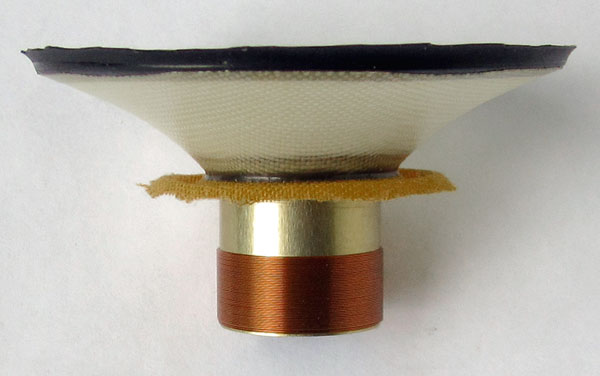
In addition, the drivers have a much longer excursion ability not normally found in small drivers Here is a picture showing the unusually long voice coil winding height. This is much greater than the magnetic front plate height and allows long linear excursions.
12. What is so unique about these drivers?
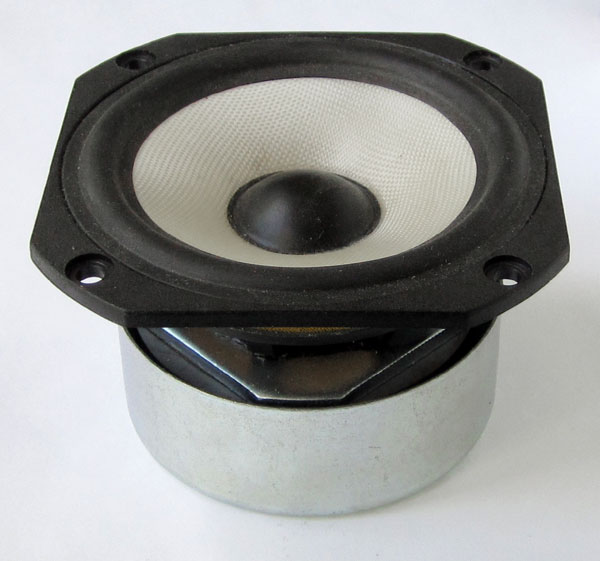
The cone is made of a woven fiberglass material. This type of textile construction has been used in various dome midranges and tweeters for many years and has proved to furnish smoother response and without the peaks sometimes found in rigid materials such as those having metal cone or dome construction. The magnet structure is not only reverse polarized but also has an external steel cover as well. It reduces stray magnetic fields that could affect the picture of an older television set if placed in close proximity. Use of a flat spider, which is the major centering device for the voice coil, assures the same linear cone travel in each direction while keeping the coil exactly centered in the magnetic gap. A thin rubber surround eliminates the possibility of deterioration over time often found with foam surrounds. The flat-sided basket allows closer spacing between the drivers.
This excellent driver has a copper shorting cylinder around the pole piece. Unlike some shorting ring designs, this ring extends through the entire height of the gap and beyond. This is known to reduce distortion, particularly in the voice range, by a factor of 10 or more. The ring also greatly reduces any impedance rise at the higher frequencies.
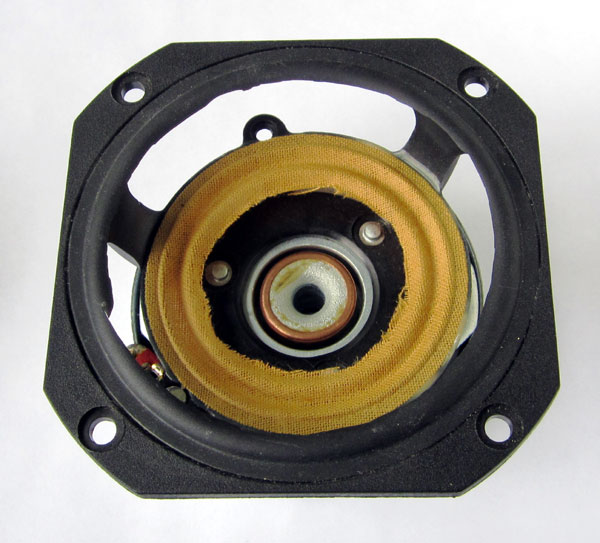
13. What is the power handling for the system?
The maximum peak power level is 250 watts. However, most of the time, you will need no more than 2 watts. This is because of the 10 dB acoustic gain over much of the audio range. It means that only one tenth of the power is needed for the same listening level compared to a single driver. However, at the lowest frequencies, the bass boost from the equalizer increases power to the column in order to maintain a constant low frequency output. As the frequency goes lower, the power to the column gradually increases. At the lowest frequency of 20 Hz, the power requirement can be up to 100 times greater. It is rare in music that frequencies this low will require this much power to match the level of the upper bass. A power amplifier of 200 to 250 watts is more than adequate for the loudest of listening levels at the lowest frequencies. At high frequencies, a boost from the equalizer also increases power to the column to accomplish a constant output. As the frequency goes higher, the power to the column gradually increases. At the highest frequency of 20 kHz, the power requirement can be 10 times or as much as 20 watts. This is not a problem for the IDS-25. You will also experience a completely effortless sound throughout the entire frequency range. The reason is the large, effective, cone area that couples so well to the air. Normally, the area available for mids and highs in most systems is very small and single drivers are easily driven into distortion at higher levels. Not only is the sound from the IDS-25 effortless but it also fills the room from top to bottom and appears to play louder than a typical point-source system. When you combine all of these impressions, it goes beyond overwhelming.
14. Isn’t there a problem with intermodulation distortion for a driver covering such a wide frequency range?
The IDS-25 has exceptionally low distortion.
When an ordinary driver is used to cover the entire frequency range, you can
expect the harmonic and intermodulation distortion to be relatively high.
However, the IDS-25 drivers have the same low distortion construction used in
design of soft dome mids and tweeters. The cone is
actually made of woven fiberglass and dissipates energy over its entire
surface, reducing edge reflections and drastically lowering distortion. In
addition, the magnet assembly employs the latest technology consisting of a
copper cylinder through the entire length of the voice coil gap. This shorting
cylinder is known to significantly reduce distortion contributed by the magnet
structure to one tenth of conventional driver distortion. This improvement is
particularly noticeable in the voice range. The diameter of the cone is small
compared to the voice coil diameter, also reducing cone distortion. What's
more, the entire magnet assembly is shielded to eliminate any stray magnetic
field that would otherwise affect the picture in some early television sets or
other devices.
RETURN
15. What about Doppler distortion when the drivers handle lows as well as highs.
Doppler distortion occurs when the cone
motion at low frequencies shifts the higher frequencies up and down at the low
frequency rate. The longer the low frequency cone excursion, the more
distortion is generated. If a single driver is used, distortion would probably
be audible at high levels. However, the IDS-25 is unusual because the diaphragm
motion of the combined 25 drivers at low frequencies is extremely small and
modulation distortion is far below audibility.
RETURN
16. What about comb filter effects caused by the driver spacing?
The closer the drivers are, the less
perceptible is any variation in sound. A spacing of one foot between drivers is
obviously too large and if you put your ear six inches from such a column and
move up and down, you will be able to clearly hear individual sources, even
further back into the room. However, the closely-spaced drivers used in the
IDS-25 perform far better. With music, you can come as close as one foot and
the sound still appears to be continuous. After hearing the IDS system, the
reactions from people who are concerned about comb filtering in columns are
surprised when they are not hearing it. This is further explained in section
23.
RETURN
17. Why is the sensitivity of the IDS-25 system higher than only one of the drivers.
There are two reasons for greater effective sensitivity compared to a conventional system. First, there is an inherent 10 dB increase in acoustic gain from this long array over most of the frequency range. Second, the sound is essentially radiated in a cylindrical pattern from floor to ceiling. The sound level decreases by only 3 dB for each doubling of listening distance. In a conventional system, such as one having a single woofer, mid and tweeter, the sound is radiated in a spherical pattern from the height of each driver. The sound level decreases 6 dB for each doubling of listening distance. The IDS-25 is able to fill the room with sound much more uniformly and at the same time project better stereo sound further into your listening room.
As a result, the
sensitivity for the system is 92.5dB for one watt at one meter distance. A
normal listening level for most music can be as high as 85 dB at a distance of
10 feet. Power levels are typically about a quarter of a watt for this
listening level. This allows plenty of headroom for dynamic peaks of 95 dB or
more and for deep bass notes that require more power. However, because the
speakers sound so attractive, it is easy to turn up the volume control for
more, even to the point of being louder than the original performance. Although
the IDS systems readily deliver excellent sound at higher levels, I am
concerned about hearing damage for extended periods of high-level listening.
RETURN
18. How good is the transient response of the system?
The transient response of the system is excellent. Good transients or “fast speakers” depend on a driver with a wide bandwidth and low moving mass. The drivers are inherently wide bandwidth. The weight of the moving parts of each IDS driver is very light, measuring only 2.5 grams or 0.088 ounces, the same weight as a dime. Although transient improvements can be easily heard, I have verified this with short tone burst tests and further confirms that the drivers have smooth, uninterrupted wide-range response.
19. What are the advantages of eliminating crossover networks?
Conventional systems, having a woofer, tweeter and perhaps a mid-range as well, require crossovers, either passive or active. Needless to say, the elimination of crossover networks takes away many of the compromises involved in juggling components, drivers, crossover frequencies and impedance to try to make the best sound using this limited technology. Having no crossover also eliminates the debate about which passive components sound the best. In addition, passive crossovers often involve losses and can cause unwanted changes to the system impedance in order to gain an improvement in response.
To put it simply, a multi-way system by its
nature chops up the signal from the power amplifier into 2 or 3 or more
frequency ranges with crossover networks, passive or electronic. This destroys
any coherence in the original signal. Then different drivers with individual
networks attempt to piece that signal back together like the original signal
from the amplifier. Shifting the frequency range to different drivers having a
different construction, resonances, dispersion and locations further complicates
these efforts. In the area of the crossover frequency, these differences
between drivers cause sudden discontinuities in the overall sound balance. It
results in a loss of valuable stereo information. A column of full range
drivers without crossovers preserves valuable coherence and transients. It
allows the original peaks such as drums, cymbals and even the bow strokes of a
violin to accurately follow the wave shape of the original signal from the
amplifier.
RETURN
20. How low does the impedance get?
The impedance is 7.2 ohms or higher throughout the frequency range. The rated impedance is 8-ohms. The impedance of some systems using crossover networks can vary widely and could dip far below the advertised impedance causing a mismatch to the power amplifier. Addition of a zobel has been tested for the IDS system but is not audible perhaps due to the simplicity of the curve. Some marginal performance amplifiers might have a problem driving very complex impedances compared to the IDS-25.
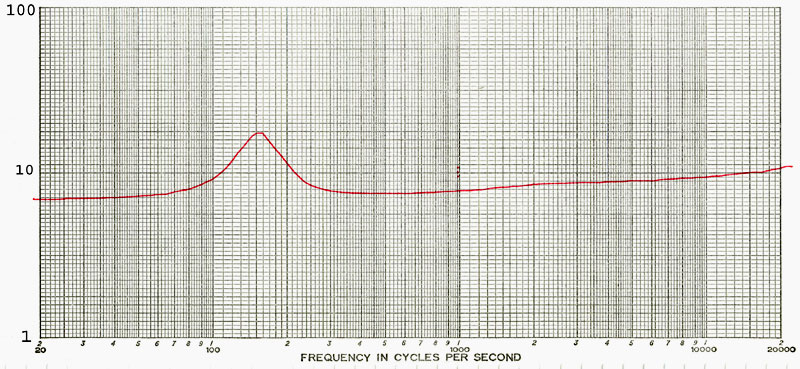
An impedance curve is a nice way to see what kind
of gymnastics have been used to create a system and what kind of trouble spots
might be there. It’s sort of like a blood test for health diagnostics. Bear in
mind that the above curve is for the entire system. The 25 drivers are wired in
series-parallel. There are five groups in series and the five groups are wired
in parallel. Because the drivers are identical, the system impedance curve is
the same as a single driver and is a relatively simple curve. The impedance
curve for many other systems wanders up and down many times over the frequency
range.
RETURN
21. What would it be like to hear a system like this?
The first impression is overwhelming and can be attributed to several different benefits. The most obvious one will probably be the unusually good bass response. When you first see the system, your eyes and past listening experience with small speakers may tell you that this system definitely needs a woofer or two or even a tweeter. Common sense may tell you that you can’t possibly get any deep bass from a bunch of 3-inch drivers. But, the bass is not only impressive; it is free from ringing and “boominess” that is found in some systems and it can be felt as well as only heard! The highs, of course, are radiated from the one inch dome attached directly to the voice coil form of each driver.
After making an adjustment for what you see versus what you hear, more advantages can be discovered. Transients are also very obvious. Because there are no crossovers, the peak levels are reproduced more accurately and this adds to the dynamic range of the sound. The response of the IDS-25 is very smooth. It is free from any resonances, peaks or dips. However, this is not enough to explain the instant reaction you get when you first hear the system. The coherence, when an entire orchestra is playing, is simply amazing. You may realize, perhaps for the first time, that the stereo image, depth and spaciousness provided by this system is totally mesmerizing and you are only aware of the performance and what the artist has created. Even if you have been able to distinguish a few of these sounds when listening to your existing speakers, the IDS-25 system can do this better because it has inherent design advantages that other systems do not have. You will most likely want to play your entire music collection over again to discover the many details and enjoyable sounds that you did not hear before
22. How much floor space does the system require?
The IDS-25 has a footprint for the base that is only 14" wide and 12" deep. The column itself is only 7-1/2" wide (tapering to 5-1/2" in front) and 9-1/4" deep. In addition, the base can be removed and system can be mounted in a wall for custom installations. Because the system is capable of significant output down to 20 Hz, no subwoofer is needed. Many systems, particularly where a subwoofer is needed, take up more valuable floor space.
23. Why does the sound seem to always come from my listening height, such as sitting or standing?
This is explained by the precedence effect, also known as the Hass Effect. This is our ability to correctly identify the direction of a sound source. The ear/brain combination is a much better instrument than conventional measurement devices. It simply states that the first sound to arrive at the ears enables us to determine the direction of the source, whether it is ahead, above or below. For the IDS system, it is the sound from the nearest part of the column and that is at the height of your ears.
After hearing an initial signal, the brain will suppress any later signal, such as an echo, for a time up to about 30 or 40 milliseconds. This inhibition is called time or temporal masking. In effect, you do not hear the sound from the higher or lower drivers that would otherwise interfere with locating the nearest source of the sound. If the arrival time of any echo is longer than this, then two distinct sounds are heard, even if the second arrival is as much as10 dB higher. This is why the sound from the IDS column always appears to be coming from your listening height and there is consequently no interference with other drivers further away.
A classic example to demonstrate temporal masking is to stand in front of a hard surface such as a brick wall that is away from other reflecting surfaces that might interfere with what you hear. By clapping your hands and gradually moving back, you will reach a point where you can begin to discern two separate sounds, your initial handclap and the echo. I used two small boards because my hands got tired of clapping. When I tried this, I measured 17 feet to the wall. The total distance, representing the time it takes for the sound to travel to the wall and back again, was 34 feet or 30.6 milliseconds. You can even tell if the distance is great or small depending on how long the reflected sound takes to return. The longer the delay is, the greater the distance you are from the wall. So you hear your hand clap first and don’t hear the echo until the time gets as long as about 30 milliseconds.
24. What kind of protection does the system have?
The system has a bistable Polyswitch device in series with the input. If the sustained power level is excessive, the Polyswitch will trip and go to a high resistance state. The excessive power will be dumped into thermal resistors and the system will not play any louder. When this happens, turn down the volume and the Polyswitch will reset automatically. However, the circuit is not guaranteed to act for excessive short term power.
25 Does the IDS really produce a deep bass or only a pseudo bass?
False Bass Perception
The IDS system can deliver deep bass despite the small driver size. However, it has been shown that if a listener is presented with a “pseudo bass,” then he will get the illusion of hearing bass deeper than it really is. For instance, if only the harmonics of a 25 Hz signal are heard, it gives the impression of hearing the fundamental of 25 Hz as well. However, a measurement of the system shows whether there really is any significant response at 25 Hz or not. This can be done using pink noise and then sweeping with a class III 1/3 octave filter. When the filter is tuned to 25Hz, the frequencies above and below 25Hz are essentially removed by the filter and pass only a narrow band centered 25Hz output.

Here is the response curve for a 1/3 octave filter and an even narrower 1/10 octave filter. You can see that at one half and at twice the frequency, the response is down 35dB for the 1/3 octave setting. The following response curve is made using a variable frequency 1/3 octave filter. If a slower averaging time is used, a smoother curve can be made but is not necessary for this example. If there is no measured output at 25Hz, then the speaker is not reproducing 25 Hz.
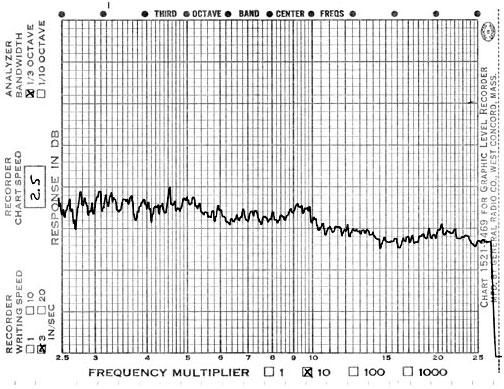
Here is the low frequency
response of the IDS system shown in the range from 25 to 250 Hz. The IDS system
has more than adequate output in the low frequency range. The measurement was
taken at the listening position and it actually has a slightly rising
characteristic of 3 to 4dB below 100Hz compared to the rest of the range. Some
of this can be attributed to the room acoustics. The speaker is located 4” from
a wall and away from the room corners. So, in fact, the filtered output proves
that the system does actually reproduce a fundamental of 25 Hz and it will go
even lower. Unlike the headphone hearing test, this system can be felt by your
body as well as heard.
RETURN
26. Yes, a
custom height column can be made for you. Eliminating one or two drivers at the
top can be easily accomplished at the factory. A compensating resistor can be
substituted and overall performance and impedance will not be noticeably
affected
RETURN
Check the IDS-25 page for more information, pictures and reviews.
